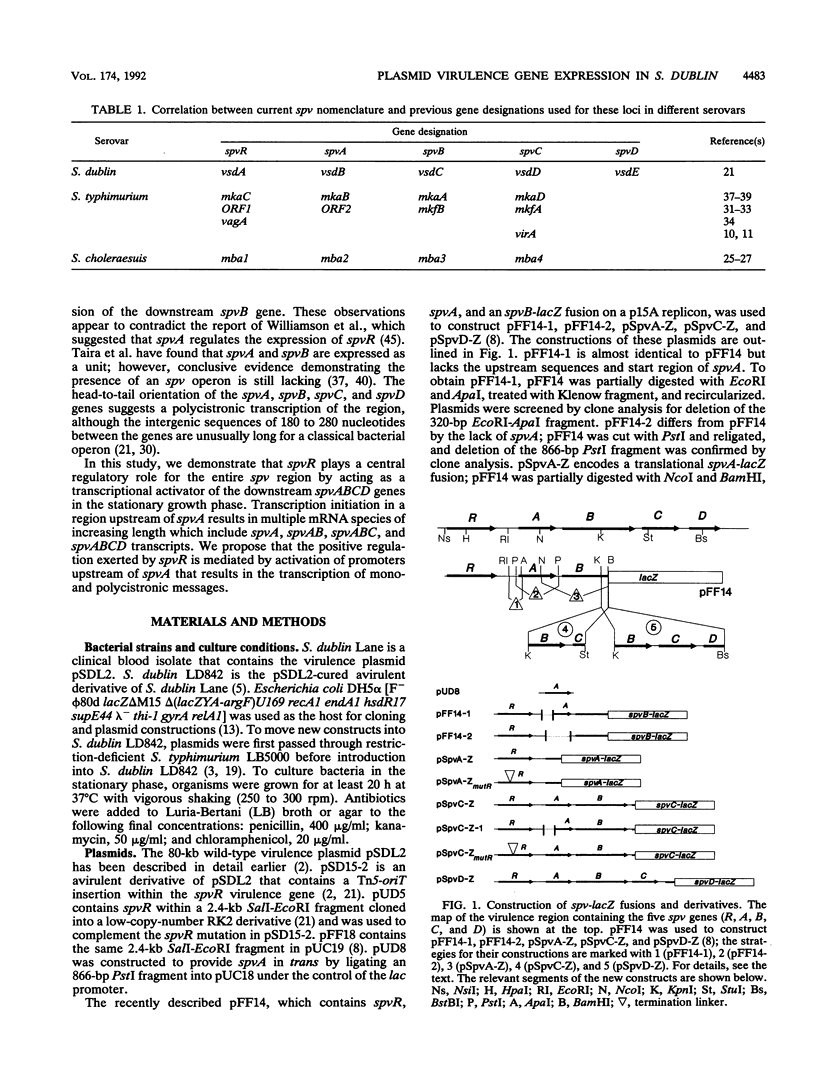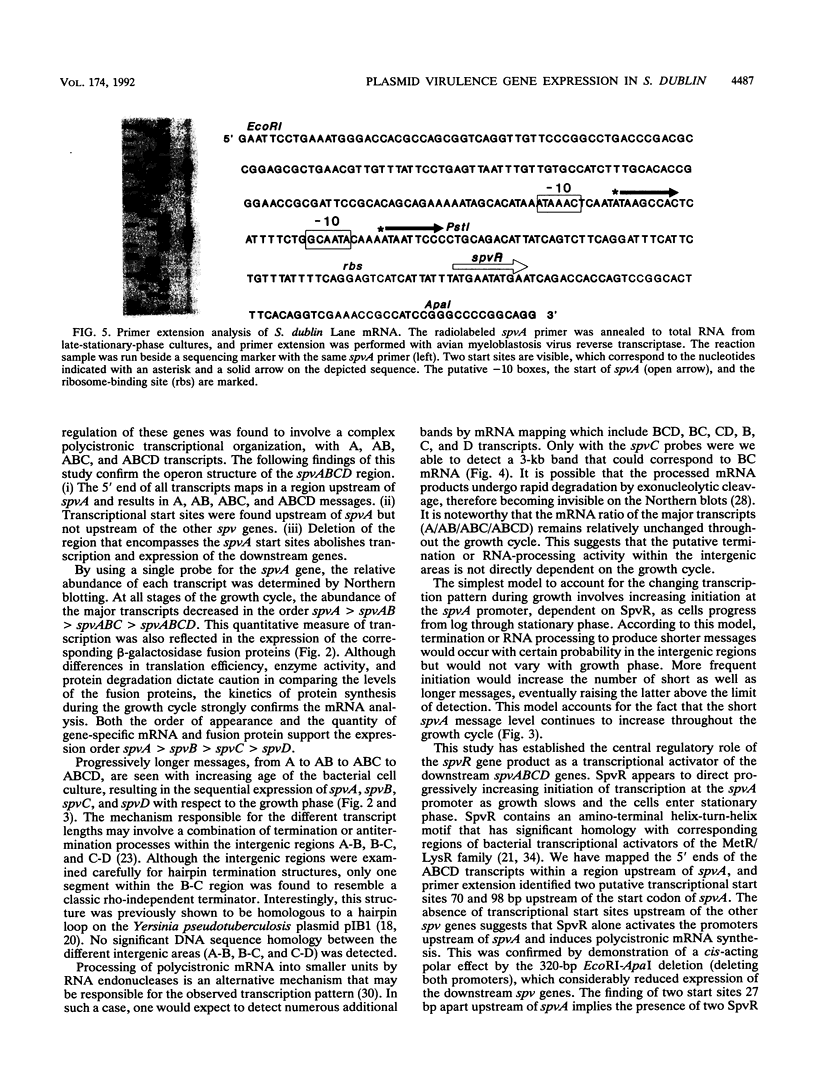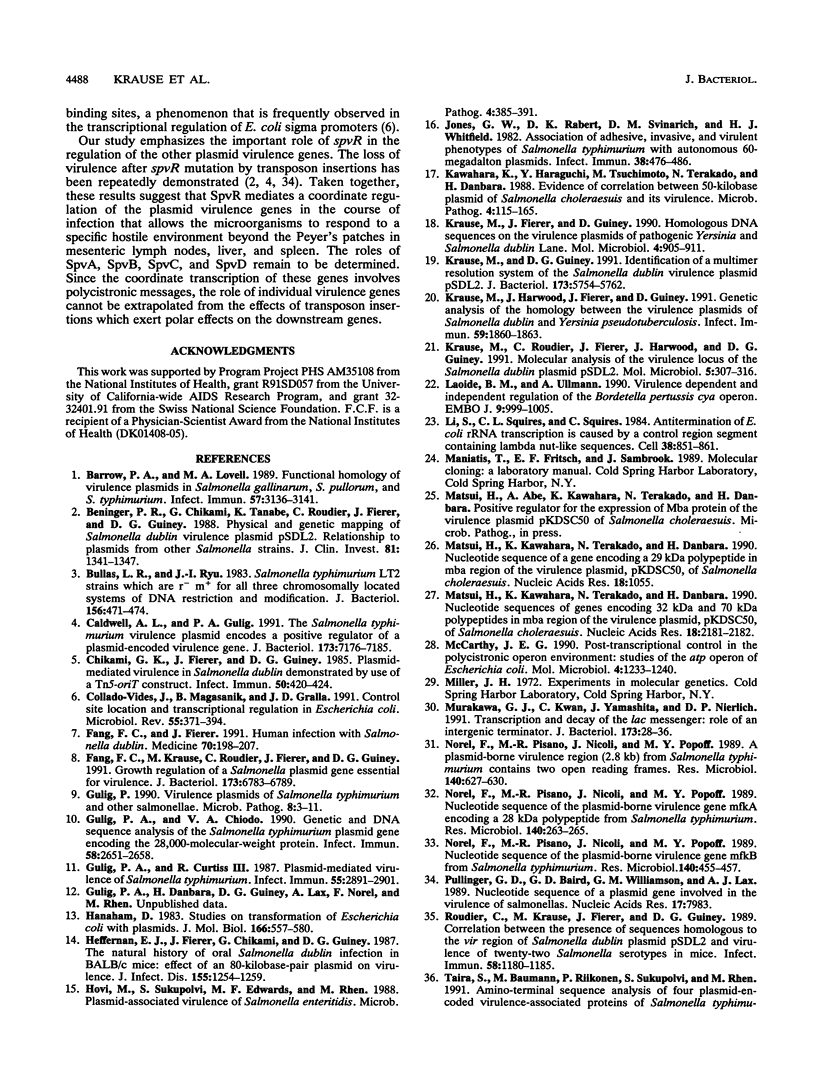Abstract
The 80-kb plasmid pSDL2 of Salmonella dublin Lane is essential for lethal systemic infection in experimental mice. A cluster of five plasmid genes, designated spvR, spvA, spvB, spvC, and spvD, is sufficient to express the plasmid-related virulent phenotype. The spvR gene product has recently been identified as a positive regulator of spvB expression in the stationary phase of bacterial growth (F. C. Fang, M. Krause, C. Roudier, J. Fierer, and D. G. Guiney, J. Bacteriol. 173:6783-6789, 1991). In this study, we evaluated the role of SpvR in the transcription of the downstream virulence genes spvABCD. Analysis of mRNA synthesis revealed that SpvR promotes transcription of the downstream spvABCD genes in the stationary growth phase. Transcript mapping of the spv region demonstrated an unusual operon structure involving messages for spvA, spvAB, spvABC, and spvABCD. Quantitative measurement of transcription and of gene expression by use of translational spv-lacZ fusions suggested that SpvA, SpvB, SpvC, and SpvD are produced in decreasing abundance. Primer extension assays identified two transcriptional start sites 70 and 98 bp upstream of the start codon of spvA, but none upstream of spvB, spvC, or spvD. Deletion of a 320-bp EcoRI-ApaI segment that contains both start sites abolished expression of the downstream spvB and spvC genes. Our results establish a central function of SpvR as a positive regulator of the downstream spvABCD genes in the stationary phase of bacterial growth and indicate that the primary mechanism of regulation is by activation of promoters upstream of spvA.
Full text
PDF







Images in this article
Selected References
These references are in PubMed. This may not be the complete list of references from this article.
- Barrow P. A., Lovell M. A. Functional homology of virulence plasmids in Salmonella gallinarum, S. pullorum, and S. typhimurium. Infect Immun. 1989 Oct;57(10):3136–3141. doi: 10.1128/iai.57.10.3136-3141.1989. [DOI] [PMC free article] [PubMed] [Google Scholar]
- Beninger P. R., Chikami G., Tanabe K., Roudier C., Fierer J., Guiney D. G. Physical and genetic mapping of the Salmonella dublin virulence plasmid pSDL2. Relationship to plasmids from other Salmonella strains. J Clin Invest. 1988 May;81(5):1341–1347. doi: 10.1172/JCI113461. [DOI] [PMC free article] [PubMed] [Google Scholar]
- Bullas L. R., Ryu J. I. Salmonella typhimurium LT2 strains which are r- m+ for all three chromosomally located systems of DNA restriction and modification. J Bacteriol. 1983 Oct;156(1):471–474. doi: 10.1128/jb.156.1.471-474.1983. [DOI] [PMC free article] [PubMed] [Google Scholar]
- Caldwell A. L., Gulig P. A. The Salmonella typhimurium virulence plasmid encodes a positive regulator of a plasmid-encoded virulence gene. J Bacteriol. 1991 Nov;173(22):7176–7185. doi: 10.1128/jb.173.22.7176-7185.1991. [DOI] [PMC free article] [PubMed] [Google Scholar]
- Chikami G. K., Fierer J., Guiney D. G. Plasmid-mediated virulence in Salmonella dublin demonstrated by use of a Tn5-oriT construct. Infect Immun. 1985 Nov;50(2):420–424. doi: 10.1128/iai.50.2.420-424.1985. [DOI] [PMC free article] [PubMed] [Google Scholar]
- Collado-Vides J., Magasanik B., Gralla J. D. Control site location and transcriptional regulation in Escherichia coli. Microbiol Rev. 1991 Sep;55(3):371–394. doi: 10.1128/mr.55.3.371-394.1991. [DOI] [PMC free article] [PubMed] [Google Scholar]
- Fang F. C., Fierer J. Human infection with Salmonella dublin. Medicine (Baltimore) 1991 May;70(3):198–207. doi: 10.1097/00005792-199105000-00004. [DOI] [PubMed] [Google Scholar]
- Fang F. C., Krause M., Roudier C., Fierer J., Guiney D. G. Growth regulation of a Salmonella plasmid gene essential for virulence. J Bacteriol. 1991 Nov;173(21):6783–6789. doi: 10.1128/jb.173.21.6783-6789.1991. [DOI] [PMC free article] [PubMed] [Google Scholar]
- Gulig P. A., Chiodo V. A. Genetic and DNA sequence analysis of the Salmonella typhimurium virulence plasmid gene encoding the 28,000-molecular-weight protein. Infect Immun. 1990 Aug;58(8):2651–2658. doi: 10.1128/iai.58.8.2651-2658.1990. [DOI] [PMC free article] [PubMed] [Google Scholar]
- Gulig P. A., Curtiss R., 3rd Plasmid-associated virulence of Salmonella typhimurium. Infect Immun. 1987 Dec;55(12):2891–2901. doi: 10.1128/iai.55.12.2891-2901.1987. [DOI] [PMC free article] [PubMed] [Google Scholar]
- Gulig P. A. Virulence plasmids of Salmonella typhimurium and other salmonellae. Microb Pathog. 1990 Jan;8(1):3–11. doi: 10.1016/0882-4010(90)90003-9. [DOI] [PubMed] [Google Scholar]
- Hanahan D. Studies on transformation of Escherichia coli with plasmids. J Mol Biol. 1983 Jun 5;166(4):557–580. doi: 10.1016/s0022-2836(83)80284-8. [DOI] [PubMed] [Google Scholar]
- Heffernan E. J., Fierer J., Chikami G., Guiney D. Natural history of oral Salmonella dublin infection in BALB/c mice: effect of an 80-kilobase-pair plasmid on virulence. J Infect Dis. 1987 Jun;155(6):1254–1259. doi: 10.1093/infdis/155.6.1254. [DOI] [PubMed] [Google Scholar]
- Hovi M., Sukupolvi S., Edwards M. F., Rhen M. Plasmid-associated virulence of Salmonella enteritidis. Microb Pathog. 1988 May;4(5):385–391. doi: 10.1016/0882-4010(88)90066-6. [DOI] [PubMed] [Google Scholar]
- Johnson W. M., Lior H. A new heat-labile cytolethal distending toxin (CLDT) produced by Campylobacter spp. Microb Pathog. 1988 Feb;4(2):115–126. doi: 10.1016/0882-4010(88)90053-8. [DOI] [PubMed] [Google Scholar]
- Jones G. W., Rabert D. K., Svinarich D. M., Whitfield H. J. Association of adhesive, invasive, and virulent phenotypes of Salmonella typhimurium with autonomous 60-megadalton plasmids. Infect Immun. 1982 Nov;38(2):476–486. doi: 10.1128/iai.38.2.476-486.1982. [DOI] [PMC free article] [PubMed] [Google Scholar]
- Krause M., Fierer J., Guiney D. Homologous DNA sequences on the virulence plasmids of pathogenic Yersinia and Salmonella dublin lane. Mol Microbiol. 1990 Jun;4(6):905–911. doi: 10.1111/j.1365-2958.1990.tb00663.x. [DOI] [PubMed] [Google Scholar]
- Krause M., Guiney D. G. Identification of a multimer resolution system involved in stabilization of the Salmonella dublin virulence plasmid pSDL2. J Bacteriol. 1991 Sep;173(18):5754–5762. doi: 10.1128/jb.173.18.5754-5762.1991. [DOI] [PMC free article] [PubMed] [Google Scholar]
- Krause M., Harwood J., Fierer J., Guiney D. Genetic analysis of homology between the virulence plasmids of Salmonella dublin and Yersinia pseudotuberculosis. Infect Immun. 1991 May;59(5):1860–1863. doi: 10.1128/iai.59.5.1860-1863.1991. [DOI] [PMC free article] [PubMed] [Google Scholar]
- Krause M., Roudier C., Fierer J., Harwood J., Guiney D. Molecular analysis of the virulence locus of the Salmonella dublin plasmid pSDL2. Mol Microbiol. 1991 Feb;5(2):307–316. doi: 10.1111/j.1365-2958.1991.tb02111.x. [DOI] [PubMed] [Google Scholar]
- Laoide B. M., Ullmann A. Virulence dependent and independent regulation of the Bordetella pertussis cya operon. EMBO J. 1990 Apr;9(4):999–1005. doi: 10.1002/j.1460-2075.1990.tb08202.x. [DOI] [PMC free article] [PubMed] [Google Scholar]
- Li S. C., Squires C. L., Squires C. Antitermination of E. coli rRNA transcription is caused by a control region segment containing lambda nut-like sequences. Cell. 1984 Oct;38(3):851–860. doi: 10.1016/0092-8674(84)90280-0. [DOI] [PubMed] [Google Scholar]
- Matsui H., Kawahara K., Terakado N., Danbara H. Nucleotide sequence of a gene encoding a 29 kDa polypeptide in mba region of the virulence plasmid, pKDSC50, of Salmonella choleraesuis. Nucleic Acids Res. 1990 Feb 25;18(4):1055–1055. doi: 10.1093/nar/18.4.1055. [DOI] [PMC free article] [PubMed] [Google Scholar]
- Matsui H., Kawahara K., Terakado N., Danbara H. Nucleotide sequences of genes encoding 32 kDa and 70 kDa polypeptides in mba region of the virulence plasmid, pKDSc50, of Salmonella choleraesuis. Nucleic Acids Res. 1990 Apr 25;18(8):2181–2182. doi: 10.1093/nar/18.8.2181. [DOI] [PMC free article] [PubMed] [Google Scholar]
- McCarthy J. E. Post-transcriptional control in the polycistronic operon environment: studies of the atp operon of Escherichia coli. Mol Microbiol. 1990 Aug;4(8):1233–1240. doi: 10.1111/j.1365-2958.1990.tb00702.x. [DOI] [PubMed] [Google Scholar]
- Murakawa G. J., Kwan C., Yamashita J., Nierlich D. P. Transcription and decay of the lac messenger: role of an intergenic terminator. J Bacteriol. 1991 Jan;173(1):28–36. doi: 10.1128/jb.173.1.28-36.1991. [DOI] [PMC free article] [PubMed] [Google Scholar]
- Norel F., Pisano M. R., Nicoli J., Popoff M. Y. A plasmid-borne virulence region (2.8 kb) from Salmonella typhimurium contains two open reading frames. Res Microbiol. 1989 Nov-Dec;140(9):627–630. doi: 10.1016/0923-2508(89)90194-0. [DOI] [PubMed] [Google Scholar]
- Norel F., Pisano M. R., Nicoli J., Popoff M. Y. Nucleotide sequence of the plasmid-borne virulence gene mkfA encoding a 28 kDa polypeptide from Salmonella typhimurium. Res Microbiol. 1989 Mar-Apr;140(3):263–265. doi: 10.1016/0923-2508(89)90081-8. [DOI] [PubMed] [Google Scholar]
- Norel F., Pisano M. R., Nicoli J., Popoff M. Y. Nucleotide sequence of the plasmid-borne virulence gene mkfB from Salmonella typhimurium. Res Microbiol. 1989 Sep;140(7):455–457. doi: 10.1016/0923-2508(89)90066-1. [DOI] [PubMed] [Google Scholar]
- Pullinger G. D., Baird G. D., Williamson C. M., Lax A. J. Nucleotide sequence of a plasmid gene involved in the virulence of salmonellas. Nucleic Acids Res. 1989 Oct 11;17(19):7983–7983. doi: 10.1093/nar/17.19.7983. [DOI] [PMC free article] [PubMed] [Google Scholar]
- Roudier C., Krause M., Fierer J., Guiney D. G. Correlation between the presence of sequences homologous to the vir region of Salmonella dublin plasmid pSDL2 and the virulence of twenty-two Salmonella serotypes in mice. Infect Immun. 1990 May;58(5):1180–1185. doi: 10.1128/iai.58.5.1180-1185.1990. [DOI] [PMC free article] [PubMed] [Google Scholar]
- Taira S., Baumann M., Riikonen P., Sukupolvi S., Rhen M. Amino-terminal sequence analysis of four plasmid-encoded virulence-associated proteins of Salmonella typhimurium. FEMS Microbiol Lett. 1991 Jan 15;61(2-3):319–323. doi: 10.1016/0378-1097(91)90573-s. [DOI] [PubMed] [Google Scholar]
- Taira S., Rhen M. Identification and genetic analysis of mkaA--a gene of the Salmonella typhimurium virulence plasmid necessary for intracellular growth. Microb Pathog. 1989 Sep;7(3):165–173. doi: 10.1016/0882-4010(89)90052-1. [DOI] [PubMed] [Google Scholar]
- Taira S., Rhen M. Molecular organization of genes constituting the virulence determinant on the Salmonella typhimurium 96 kilobase pair plasmid. FEBS Lett. 1989 Nov 6;257(2):274–278. doi: 10.1016/0014-5793(89)81551-0. [DOI] [PubMed] [Google Scholar]
- Taira S., Rhen M. Nucleotide sequence of mkaD, a virulence-associated gene of Salmonella typhimurium containing variable and constant regions. Gene. 1990 Sep 1;93(1):147–150. doi: 10.1016/0378-1119(90)90150-p. [DOI] [PubMed] [Google Scholar]
- Terakado N., Sekizaki T., Hashimoto K., Naitoh S. Correlation between the presence of a fifty-megadalton plasmid in Salmonella dublin and virulence for mice. Infect Immun. 1983 Jul;41(1):443–444. doi: 10.1128/iai.41.1.443-444.1983. [DOI] [PMC free article] [PubMed] [Google Scholar]
- Valone S. E., Chikami G. K. Characterization of three proteins expressed from the virulence region of plasmid pSDL2 in Salmonella dublin. Infect Immun. 1991 Oct;59(10):3511–3517. doi: 10.1128/iai.59.10.3511-3517.1991. [DOI] [PMC free article] [PubMed] [Google Scholar]
- Williamson C. M., Baird G. D., Manning E. J. A common virulence region on plasmids from eleven serotypes of Salmonella. J Gen Microbiol. 1988 Apr;134(4):975–982. doi: 10.1099/00221287-134-4-975. [DOI] [PubMed] [Google Scholar]
- Williamson C. M., Pullinger G. D., Lax A. J. Identification of an essential virulence region on Salmonella plasmids. Microb Pathog. 1988 Dec;5(6):469–473. doi: 10.1016/0882-4010(88)90008-3. [DOI] [PubMed] [Google Scholar]
- Williamson C. M., Pullinger G. D., Lax A. J. Identification of proteins expressed by the essential virulence region of the Salmonella dublin plasmid. Microb Pathog. 1990 Jul;9(1):61–66. doi: 10.1016/0882-4010(90)90041-n. [DOI] [PubMed] [Google Scholar]





